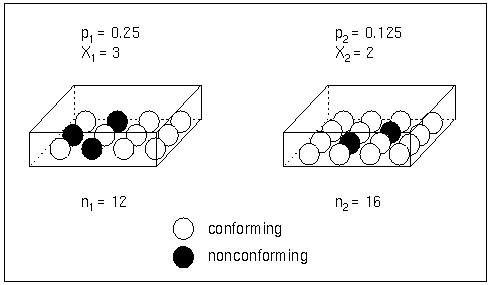PCHART Statement: SHEWHART Procedure
The following notation is used in this section:
|
p |
expected proportion of nonconforming items produced by the process |
|
|
proportion of nonconforming items in the ith subgroup |
|
|
number of nonconforming items in the ith subgroup |
|
|
number of items in the ith subgroup |
|
|
average proportion of nonconforming items taken across subgroups: |
|
N |
number of subgroups |
|
|
incomplete beta function: for |
Each point on a p chart represents the observed proportion (![]() ) of nonconforming items in a subgroup. For example, suppose the second subgroup (see Figure 17.68) contains 16 items, of which two are nonconforming. The point plotted for the second subgroup is
) of nonconforming items in a subgroup. For example, suppose the second subgroup (see Figure 17.68) contains 16 items, of which two are nonconforming. The point plotted for the second subgroup is ![]() .
.
Note that an ![]() chart displays the number (count) of nonconforming items
chart displays the number (count) of nonconforming items ![]() . You can use the NPCHART statement to create
. You can use the NPCHART statement to create ![]() charts; see NPCHART Statement: SHEWHART Procedure.
charts; see NPCHART Statement: SHEWHART Procedure.
By default, the central line on a p chart indicates an estimate of p that is computed as ![]() . If you specify a known value (
. If you specify a known value (![]() ) for p, the central line indicates the value of
) for p, the central line indicates the value of ![]() .
.
You can compute the limits in the following ways:
-
as a specified multiple (k) of the standard error of
 above and below the central line. The default limits are computed with k = 3 (these are referred to as
above and below the central line. The default limits are computed with k = 3 (these are referred to as  limits).
limits).
-
as probability limits defined in terms of
 , a specified probability that
, a specified probability that  exceeds the limits
exceeds the limits
The lower and upper control limits, LCL and UCL, respectively, are computed as

A lower probability limit for ![]() can be determined using the fact that
can be determined using the fact that
![\[ \begin{array}{ll} P\{ p_ i < \mbox{LCL}\} & = 1 - P\{ p_ i \geq \mbox{LCL}\} \\ & = 1 - P\{ X_ i \geq n_ i\mbox{LCL}\} \\ & = 1 - I_{\bar{p}}(n_ i\mbox{LCL},n_ i+1-n_ i\mbox{LCL}) \\ & = I_{1- \bar{p}}(n_ i+1-n_ i\mbox{LCL},n_ i\mbox{LCL}) \\ \end{array} \]](images/qcug_shewhart0208.png)
Refer to Johnson, Kotz, and Kemp (1992). This assumes that the process is in statistical control and that ![]() is binomially distributed. The lower probability limit LCL is then calculated by setting
is binomially distributed. The lower probability limit LCL is then calculated by setting
and solving for LCL. Similarly, the upper probability limit for ![]() can be determined using the fact that
can be determined using the fact that
The upper probability limit UCL is then calculated by setting
and solving for UCL. The probability limits are asymmetric around the central line. Note that both the control limits and
probability limits vary with ![]() .
.
You can specify parameters for the limits as follows:
-
Specify k with the SIGMAS= option or with the variable
_SIGMAS_in a LIMITS= data set. -
Specify
 with the ALPHA= option or with the variable
with the ALPHA= option or with the variable _ALPHA_in a LIMITS= data set. -
Specify a constant nominal sample size
 for the control limits with the LIMITN= option or with the variable
for the control limits with the LIMITN= option or with the variable _LIMITN_in a LIMITS= data set. -
Specify
 with the P0= option or with the variable
with the P0= option or with the variable _P_in a LIMITS= data set.

